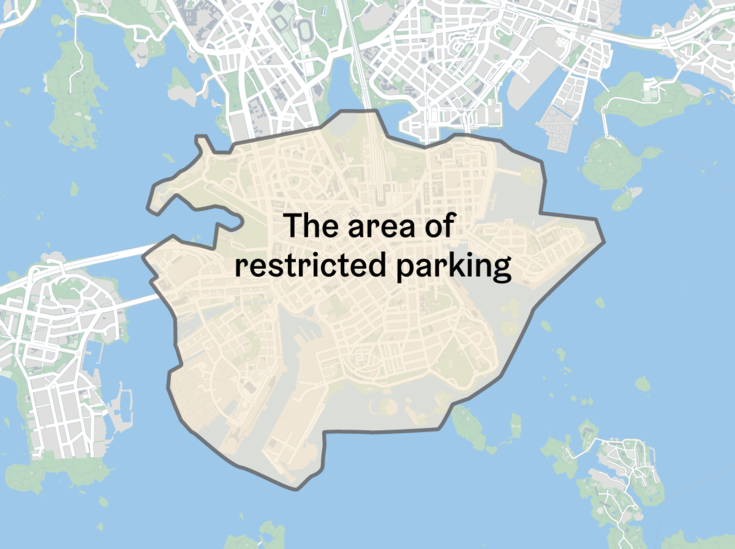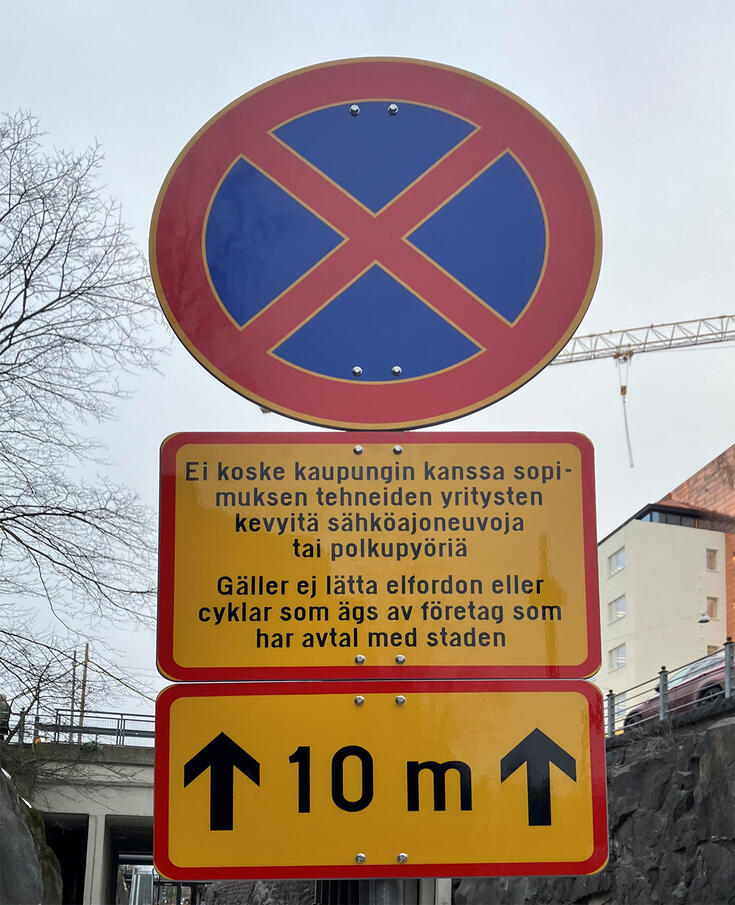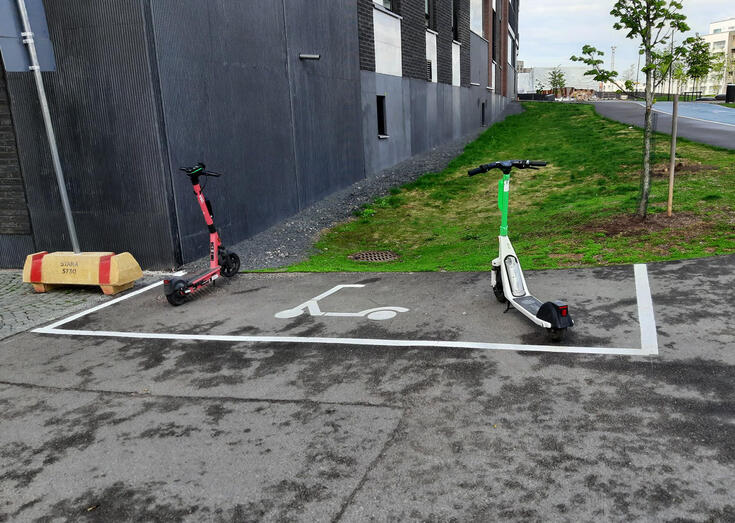Electric scooters – Frequently asked questions
Electric scooters – Frequently asked questionsThe City of Helsinki has compiled answers to frequently asked questions about electric scooters and their use in Helsinki.
Find upcoming events at the Events.hel.fi website.
Find municipal decisions in the Decision-making section.
The City of Helsinki has compiled answers to frequently asked questions about electric scooters and their use in Helsinki.

a) How will the parking of electric scooters be restricted in the city centre in 2023?
b) In which area will parking be restricted?
c) How much do operators pay for the use of parking areas?
d) Where can I park? How are the areas marked?
e) Why is there a no-stopping area?
f) Where can I report improperly parked scooters?
a)Can the city take rentable electric scooters to a storage facility?
b) How much does it cost to remove an electric scooter
c) What kind of parking is obstructive to traffic?
a) How many companies rent out scooters in Helsinki?
b) What can the city do to prevent the nuisance caused by electric scooters?
c) How have the nuisances caused by scooters been prevented so far?
d) Why does it require a permit to set up a terrace on the street but not to park an electric scooter?
e) Could the city restrict the parking of electric scooters?
f) How could the number of electric scooters be regulated?
Electric scooters with a maximum speed of 25 km/h must be ridden on a cycling path and lane or, if there are none, on the road or on the side of the road. Riding on the pavement is not permitted.
If you ride on the pavement, the police may issue you with a traffic penalty fee or a fine for endangering traffic safety.
Electric scooters are equated with bicycles in the Road Traffic Act. Therefore, you should park parallel to the road and as close to the side of the road as possible. According to the Road Traffic Act , an electric scooter may be parked or stopped on the pavement or cycling path, but in such a way that it does not obstruct traffic or movement.
In 2023, the parking of electric scooters in Helsinki city centre is restricted, see section 2 for more details. “Restricted area for electric scooters in the city centre 2023.” .
No. According to the Road Traffic Act, an electric scooter may not carry more persons than it is designed for. A passenger is permitted only if the vehicle is equipped with a designated seat for a passenger.
The city recommends the wearing of a helmet when riding an electric scooter. However, the Road Traffic Act does not mandate the use of a helmet when riding an electric scooter.
The city has decided to restrict the parking of shared-use electric scooters in the city centre in 2023 by using road signs with text. The decision was made by the Urban Environment Committee.
Parking will be restricted in the city centre and in the southern part of the inner city, see map below.
The fee is charged based on the number of electric scooters. The fee for one electric scooter board is €15/month. One operator can have a maximum of 700 electric scooters in the restricted area, in which case the operator will pay €10,500/month.
There are around 250 parking spaces for shared-use electric scooters in the restricted area. Some of them are located in squares and marketplaces, while others are on the roadside.
The parking areas are marked with road signs prohibiting the stopping of vehicles other than those of the companies with which the city has signed an agreement.
Most of the parking areas are also marked by road markings with a symbol depicting an electric scooter. The city has obtained an exemption from Traficom for the use of these road markings.
The parking areas are also marked in the operator-specific applications.
The city deliberately opted to prohibit stopping to prevent any ambiguity among the operators and scooter users as to the rules applied outside the designated areas.
The prohibition also means that short-term stopping to run an errand, for example, is only allowed in the separately marked micromobility parking spaces.
In the first instance, you should report improperly parked scooters directly to the operators:
The companies that rent out electric scooters are Bird, Bolt, Ryde, Dott and Voi.
Contact details for the companies to report faults or provide other feedback:
Bird(Link leads to external service) (online form)
Bolt(Link leads to external service) (online form)
Ryde(Link leads to external service) (online form) or tel. 07 5325 1144



Yes, the municipal parking control carries out storage and local removals for parked electric scooters that cause a significant nuisance.
A separate appealable decision is made for each individual removal.
The city charges a removal fee of €60 for each scooter removed to a storage facility. The fee for a local removal is €55.
In addition, there is a fee of €15 for each starting seven-day period of storage. The owner of the scooter is charged the fees.
The fees are decided by the City’s Urban Environment Committee’s Environment and Permits Sub-Committee. (A link to the newest decision)(Link leads to external service)
A scooter is parked in a way that obstructs traffic, for example, if it is parked on the pavement and prevents wheelchairs or prams from passing.
There are currently (autumn 2024) five companies that rent out electric scooters in Helsinki.
The companies that rent out electric scooters are Bird, Bolt, Ryde, Dott and Voi.
The city, as the road keeper, can direct traffic by installing road signs in accordance with the Road Traffic Act. Based on these powers, the city has decided to restrict the parking of shared-use electric scooters in the city centre in 2023 by using road signs with text.
The city also actively engages in discussions with the companies renting out electric scooters, the Ministry of Transport and Communications and other cities to find common solutions and amend the legislation.
The city has decided to restrict the parking of shared-use electric scooters in the city centre in 2023 by using road signs with text.
The City of Helsinki and the companies that rent out electric scooters have agreed on changes to the renting policies, which will improve traffic safety and parking.
The changes made so far include:/p>
The city has been working in cooperation with the police – in an effort to stop people from riding on the pavement, speeding and carrying more than one person.
The police will impose a €40 traffic penalty fee for offences such as riding on the pavement, carrying another person and riding into the wrong direction on a one-way street.
The lease of a terrace area is based on the Tenancy Act, under which the city requires a permit and charges a fee. The parking of electric scooters and other vehicles is based on the Road Traffic Act, which equates scooters with bicycles. The law provides that a bicycle or moped may be stopped or parked on the pavement and cycling path.
The parking of electric scooters can be prohibited or restricted by using a road sign with text.
The city has decided to restrict the parking of shared-use electric scooters in the city centre in 2023 by using road signs with text. The decision was made by the Urban Environment Committee.
According to the city’s interpretation, effectively regulating the number of electric scooters would require a legislative amendment so as to make micromobility services a licensable activity. In practice, this would mean that cities would be able to tender for licences for companies renting out scooters in the future.
Based on international examples, the nuisances caused by the number of electric scooters have only been brought under control by legislative amendments. In Norway, for example, the law was changed to allow cities to regulate electric scooter operations in their own areas. Prior to the legislative amendment, Oslo had 25,000 electric scooters in 2021, whereas in 2022, the city was able to set a limit of 8,000 scooters.
The City of Helsinki actively engages in discussions with the Ministry of Transport and Communications on this topic. Similar needs also exist in other cities.
Enabling cookies that collect statistics will allow you to share your input.